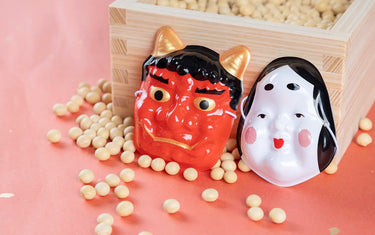The products we used:
Spring begins with Setsubun
Setsubun is a traditional Japanese festival usually celebrated on February 3rd (rarely on the 2nd or 4th), marking the transition from winter to spring. The term "Setsubun" translates to "seasonal division," and the festivities are deeply rooted in Japanese folklore and customs. The celebration involves various rituals, with one of the most iconic being "mamemaki" or throwing soybeans. This act is believed to drive away evil spirits and invite good fortune.
The significance of Setsubun goes beyond mere bean-throwing. It is a time for purification, symbolized by the scattering of beans to cleanse homes of malevolent forces. Additionally, protective rituals such as hanging holly leaves on doors aim to ward off evil spirits. Setsubun also involves a special sushi roll called "ehomaki," filled with seven lucky ingredients, consumed in silence while facing a specific direction for good fortune.
What's with the beans?

Mamemaki, the act of throwing soybeans during Setsubun, serves a dual purpose: driving away evil spirits and welcoming good fortune. By energetically tossing soybeans, people symbolically expel negative energies from their homes. The accompanying chant, "Oni wa soto! Fuku wa uchi!" ("Out with demons! In with good luck!"), intensifies the positive energy infused into the space.
Soybeans, chosen for their purifying symbolism, are scattered throughout the house to cleanse living spaces. This ritual aims to create an environment free of spiritual impurities and conducive to positive energies. Mamemaki is not just a playful tradition; it symbolizes renewal, representing the transition from winter to spring. In essence, it's a purposeful act deeply connected to the pursuit of purification, protection, and collective well-being during Setsubun.
Your lucky sushi stick


Japanese don't only throw beans on Setsubun. They also eat sushi.
Ehomaki, translated as "lucky direction roll," is a special type of sushi roll associated with the Setsubun festival in Japan. The term "eho" means "lucky direction," and "maki" refers to a roll. Ehomaki is consumed as part of a traditional ritual during Setsubun to bring good luck and prosperity for the coming year.
A unique aspect of ehomaki consumption is that it must be eaten in silence while facing a specific direction considered auspicious for that particular year. The lucky direction is determined by the Chinese zodiac sign of the year.
By the way, the lucky direction for 2024 is Southeast.
If you are interested in learning how to make Ehomaki, check out our guide and get cooking.
A Protective Soup

A lesser known tradition, typically found in the Kanto region of Japan, is the tradition of eating Kenchin-jiru, a vegetable soup. Think of Kenchin-jiru as a miso soup packed with a lot of vegetables. Since you've been practicing making miso soup after reading our guide to making miso soup, Setsubun is a good time to make use of your skills to ward off the evil spirits trying to ruin your 2024.
Locked And Loaded With Soybeans
With soybeans, Ehomaki, and Kenchin-jiru, you are armed with the essential weapons for defending and cleansing yourself against the dark forces of winter. Hold on just a little longer, because spring is coming.














